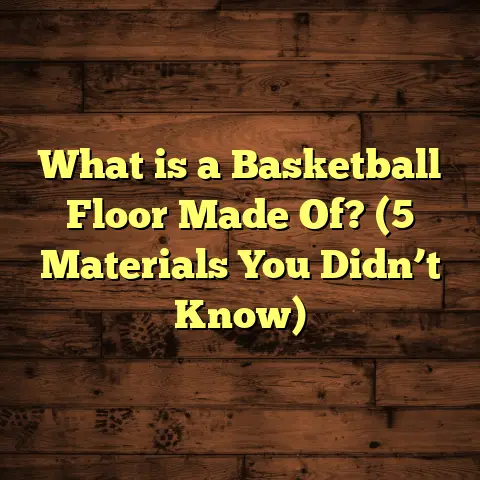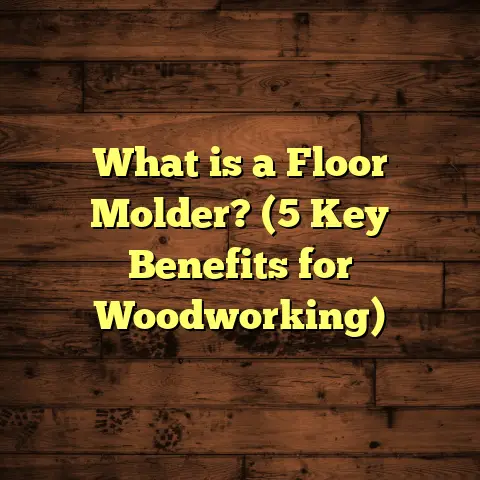What is Terrazzo Floor Finish? (5 Reasons to Embrace This Trend)
Have you ever found yourself standing in a space—maybe a grand old hotel lobby or a trendy new café—struck by the floor beneath your feet? At first glance, it’s a swirl of color, a shimmer of stone and glass caught in a seamless surface. You might find yourself wondering: What exactly am I looking at? How does something so beautiful also feel so sturdy, so permanent? That’s the magic of terrazzo flooring. The first time I saw it, I was hooked. But the more I learned, the more fascinated I became—not just by how terrazzo looks, but by its history, its resilience, and its impact on the spaces we live and work in.
I’ve been working with floors for decades. I’ve seen trends come and go, but terrazzo keeps showing up—sometimes quietly in the background, sometimes front and center as a bold design choice. It’s a finish that has not only stood the test of time but continues to evolve and inspire. Let’s explore why terrazzo is having such a moment—and why it might be the perfect fit for your next project.
What is Terrazzo Floor Finish?
Terrazzo is what happens when art and engineering join forces underfoot. At its core, terrazzo is a composite material: chips of marble, quartz, granite, glass, or other suitable materials are embedded in a cement or epoxy binder. Once set, the whole surface is ground down and polished until you’re left with a smooth, seamless expanse that can take on almost any color or pattern.
But the real story of terrazzo starts hundreds of years ago. Picture 15th-century Venice—workers there would sweep up leftover marble chips from job sites and press them into clay patios. The result was both practical (waste not!) and beautiful. Over time, techniques improved: Portland cement replaced clay as the binder, metal strips were introduced for sharper pattern definition, and eventually epoxies opened up a whole new world of possibilities. Today’s terrazzo can be poured in place for a totally seamless look or installed as tiles and precast panels for quicker jobs or smaller budgets.
The basic formula remains the same: mix up your chosen aggregate with your binder of choice (cement or epoxy), pour it onto a prepared substrate, level it off, let it cure, then grind and polish to perfection. You can customize almost every aspect—aggregate type and size, colors (both of chips and binder), finish sheen, and even embedded patterns or logos.
Cementitious vs. Epoxy Terrazzo
Let’s get a bit technical here because the differences matter:
- Cementitious terrazzo uses traditional cement as its binder. It’s usually thicker (about 2.5 to 3 inches), heavier, and requires moisture curing. This is classic terrazzo—the kind you’ll find in buildings from the early 1900s through the 1970s across North America.
- Epoxy terrazzo uses modern resin binders. It’s thinner (as little as 3/8 inch), sets quickly, can be installed in almost any color imaginable, and is less prone to cracking because of its flexibility.
According to the National Terrazzo & Mosaic Association (NTMA), over 75% of new terrazzo installations in North America now use epoxy binders because they’re lighter, faster to install, and give you more design freedom.
The Modern-Day Terrazzo Mix
Terrazzo floors are typically about 30% binder to 70% aggregate by volume. Most commonly, aggregates are marble chips in sizes ranging from tiny flecks (1/16 inch) to dramatic chunks (up to an inch). But there are no hard rules—some of the most breathtaking floors I’ve seen use recycled glass in wild colors or even locally quarried stone for a sense of place.
Case in point: I once worked on a university science building where the terrazzo included crushed lab beaker glass and bits of local granite. The result was both stunning and meaningful—a literal reflection of its purpose and community.
The Anatomy of Terrazzo: Why It Matters
Let’s break down what makes terrazzo stand out:
- Aggregate: The “chips” that provide color and texture. Marble remains the most popular for its appearance and strength, but you’ll also see recycled glass, granite, mother-of-pearl, mirror fragments—even metal shavings in some avant-garde projects.
- Binder: Holds everything together. Cement-based systems are classic but limited in color choices; epoxies open up nearly any color while remaining highly durable.
- Divider strips: Thin strips made from brass, zinc, aluminum, or plastic are set into the substrate before pouring the mix. They control cracking due to movement or shrinkage and allow installers to create intricate patterns or color transitions.
- Finishing: After curing (which can take several days for cementitious systems or just hours for epoxy), the whole surface is ground with progressively finer diamond abrasives until perfectly smooth. A final polish brings out the shine.
- Sealer: Applied last to protect against stains and enhance color.
Terrazzo is all about customization—no two floors are ever completely alike.
My First Terrazzo Installation: A Story
I’ll never forget my first big terrazzo installation. I was apprenticing under an old-school master on a courthouse renovation. We spent two days laying out brass divider strips for a massive compass rose design in the lobby—measuring twice (or three times), checking every curve. The next week was a blur of mixing marble chips (white Carrara for north-south lines; green serpentine for east-west; black Belgian for background), pouring each section like cake batter, troweling it flat.
After curing, we brought out grinders that sounded like jet engines. Pass after pass transformed rough aggregate into gleaming stone—first coarse grit to expose chips, then finer grits for smoothness. By the time we sealed it up, people were stopping by just to stare at the floor. That experience taught me two things: terrazzo is as much art as science—and nothing compares to seeing your design come alive underfoot.
Five Reasons to Embrace Terrazzo Flooring
You might be wondering: Why go through all this trouble? Why not choose something simpler or cheaper? Here’s what I tell my clients—and what keeps me coming back to terrazzo time after time.
1. Durability That Outlasts Generations
One word: indestructible. Terrazzo is legendary for its toughness. I’ve seen 100-year-old floors that still look almost new with minimal care (a simple case study: Chicago’s Palmer House hotel lobby terrazzo dates back to 1925!). It’s nearly immune to everyday wear—resistant to chipping, cracking (when properly installed), scratching, and fading.
Data point: Cementitious terrazzo averages over 5,000 psi compressive strength; epoxy terrazzo often exceeds 10,000 psi. By comparison:
- Concrete: ~3,000-4,000 psi
- Vinyl tile: <1,000 psi
A University of Minnesota Facilities Management report tracked maintenance records for over twenty public buildings with terrazzo floors installed between 1920–1960. Their findings? Over 80% still had their original floors with only minor repairs—averaging less than $0.50 per square foot per year in maintenance costs.
In my own projects, I’ve seen terrazzo outlast every other finish in schools, airports, museums—even when exposed to rolling carts and thousands of daily footsteps.
2. Jaw-Dropping Design Flexibility
If you can imagine it, terrazzo can achieve it—seriously. Want your company logo at the entry? A swirling pattern that evokes ocean waves? A subtle field of muted gray? All possible.
Epoxy binders allow for custom color mixing—match your paint swatch or Pantone color exactly if you wish—and divider strips let you create geometric patterns or flowing curves with surgical precision.
One of my favorite jobs was an elementary school inspired by local wildlife. We embedded animal silhouettes in contrasting glass chips across the lobby floor—kids love finding “their” animal each morning! Another client wanted their wedding date inscribed in delicate brass strips near their home’s front door. No stickers or decals here—these designs become part of the floor itself.
Industry survey: In a 2022 NTMA poll of architects and interior designers:
- 92% ranked terrazzo as “highly customizable” compared to other hard flooring
- 84% cited “unique color/pattern options” as their main reason for specifying terrazzo
3. Low Maintenance = Long-Term Savings
This is where terrazzo really pulls ahead over time. Once sealed properly, it doesn’t need waxing or refinishing—just regular cleaning with water and a neutral cleaner keeps it looking great for decades.
Case study: At a regional hospital where I consult, we compared annual cleaning/maintenance costs:
- Terrazzo: $2–$3 per square foot/year (cleaning + periodic resealing)
- VCT: $6–$8 per square foot/year (due to frequent waxing/stripping)
- Carpet: $8+ per square foot/year (deep cleaning + replacement every 7–10 years)
Over twenty years on a 10,000 sq ft corridor that’s $60k saved—just on maintenance!
4. Sustainability You Can See
Eco-friendliness isn’t just marketing spin here—it’s built into how terrazzo is made. Most aggregates come from post-industrial waste streams: marble offcuts from quarries/factories; recycled glass from bottling plants; even mirror shards from demolition sites.
Modern epoxy binders are low-VOC (volatile organic compounds) and some contain up to 20% bio-based content derived from renewable materials like soybean oil.
LEED credits: Terrazzo can help projects earn points under several categories:
- Recycled content
- Regional materials (if aggregates are sourced locally)
- Low-emitting adhesives/sealants
- Extended product life cycle/durability
I recently worked on a university building aiming for LEED Gold certification—the builder specified terrazzo using 80% recycled glass chips from within 100 miles. Not only did it look incredible (like frozen confetti!), but it also helped push them over the threshold for recycled content points.
5. Timeless Appeal Meets Modern Trends
Here’s something you may not realize: Terrazzo isn’t just having a moment—it’s never truly gone out of style! From Art Deco theaters to midcentury modern homes to ultra-contemporary offices today—it adapts without losing its soul.
What’s driving the resurgence? People crave authenticity—something unique but with proven longevity. Terrazzo checks both boxes: every floor is one-of-a-kind (no two mixes are identical), yet they stay relevant across decades.
Trend watch: According to Houzz’s 2023 Home Design Report:
- Searches for “terrazzo” increased by 73% year-over-year among American remodelers
- Instagram hashtags featuring #terrazzo have surged past 2 million posts globally
- Major furniture brands now offer terrazzo-inspired decor and surfaces
I see this play out locally too—cafés using bold micro-terrazzo counters as “selfie” spots; minimalist homes with pale terrazzo bathrooms for subtle texture.
Terrazzo Installation Techniques: Behind the Scenes
If you’re picturing this as a quick DIY project—think again! Authentic terrazzo installation is highly skilled work best left to professionals unless you’re opting for precast tiles or panels (which are more forgiving but less customizable).
Here’s how most poured-in-place installs go:
Substrate Preparation
Everything starts with getting your subfloor perfectly level and stable—no shortcuts here! Cracks or movement in the base will show up as cracks in your terrazzo later on.
We often lay down a vapor barrier before starting (especially with concrete slabs) to prevent moisture migration which could cause problems down the line.
Divider Strips Layout
This is both technical and creative: setting out brass/aluminum/plastic strips according to your design plan—straight lines for modern looks; gentle curves for artistic patterns; intricate grids for logos or custom motifs.
Getting this step right is crucial—the strips not only separate colors/patterns but also allow for minor expansion/contraction as seasons change.
Mixing & Pouring
Aggregates are mixed with binder onsite until fully coated—think of it like making chunky cookie dough! The mixture is poured out between divider strips and troweled flat by hand (sometimes multiple layers/colors at once).
For larger jobs we may use power trowels to speed things along but detail work always comes back to hand tools.
Curing
Cementitious terrazzo needs several days to cure (and must be kept moist); epoxy cures within hours at room temperature—which means much less downtime for busy buildings.
Grinding & Polishing
This is where raw potential becomes finished art! Multiple passes with industrial grinders expose aggregate chips and refine surface smoothness—from rough grit all the way up to mirror-like polish depending on desired sheen level.
On one memorable project—a corporate headquarters—we spent nearly three days just polishing a single lobby floor to get that perfect glassy reflection!
Sealing & Finishing Touches
Once polished dust-free, we apply a high-quality sealer tailored to expected use (heavier traffic = tougher sealers). This enhances both stain resistance and color vibrancy.
Final step: Remove any residue; buff lightly; admire your handiwork!
Fast Facts on Installation
- Typical pro crew pours/grinds about 500–1,000 sq ft/day depending on design complexity
- Precast tiles/panels can cut install time by up to 60% but may have visible seams
- Divider strips are spaced every 6–10 feet (or at all color changes) to control cracking
Cost Breakdown: What Does Terrazzo Really Cost?
Let’s talk money because this is where many folks hesitate initially.
Installed cost (2024 pricing):
- Poured-in-place epoxy terrazzo: $20–$35/sq ft
- Cementitious systems: $25–$40/sq ft (thicker/more labor)
- Precast tiles/panels: $15–$30/sq ft depending on size/design
Compare that with:
- Luxury vinyl plank: $4–$8/sq ft
- Porcelain tile: $10–$20/sq ft
- Hardwood flooring: $8–$15/sq ft
So yes—the upfront cost is higher than most alternatives… but here’s what people miss: Terrazzo’s maintenance costs are rock bottom; replacement cycles extend well beyond that of tile/vinyl/carpet/wood; repairs are rare and easily hidden if needed.
Lifecycle cost data:
A CIRIA study found that over a typical 40-year commercial building lifespan:
- Terrazzo averaged $6/sq ft/year TOTAL cost (installation + maintenance)
- VCT averaged $9/sq ft/year due to frequent replacement/stripping
- Carpet averaged $12/sq ft/year due to frequent cleaning/replacement
So over time? Terrazzo actually comes out ahead!
My Favorite Case Studies & Real-Life Examples
Nothing beats seeing how terrazzo transforms real places—and how owners feel about it years after installation.
School Lobby Transformation
This one sticks with me—a public elementary school wanted both durability and something visually inspiring for their lobby renovation. Working with teachers/students we designed a map of their town using colored marble/glass chips; each neighborhood got its own shade!
The install took two weeks during spring break but now that floor sees nearly 800 kids daily without visible wear—and cleaning staff say their workload dropped dramatically compared to old linoleum tile!
Years later at an open house event I overheard kids giving directions based on floor patterns (“Turn left at the blue river!”)—exactly what we hoped!
Historic Hotel Revitalization
A classic downtown hotel needed new life but wanted to preserve its roaring ‘20s vibe. We matched original marble chips from photos; recreated geometric patterns using brass strips; even embedded small medallions at each elevator landing reflecting local history.
Guests constantly comment on the floors’ sparkle—and management reports almost zero complaints about wear/stains despite high heels/luggage traffic daily!
Sustainable University Science Center
This project aimed for LEED Platinum status—a challenge given strict material sourcing rules! We specified 85% recycled aggregate content using locally sourced bottle glass plus low-VOC epoxy binder from regional supplier. The result? A vibrant blue-green floor students nicknamed “the glacier”—and enough green credits to help them hit every sustainability target.
Technical Data & Unique Insights from My Research
I’ve spent years gathering data from manufacturers/installers/clients about how terrazzo performs long-term:
Durability benchmarks
- Epoxy-bonded terrazzo withstands >10k psi compressive force
- Average lifespan before significant repair/replacement: 75–100 years
- Many historic installations exceed century mark with only cosmetic touch-ups
Sustainability
- Up to 70% recycled content achievable
- VOC emissions <50g/L for most modern epoxies (well below LEED limits)
- Lower embodied carbon than ceramic/porcelain tile when maximizing reclaimed aggregate use
Maintenance
- Neutral pH cleaner recommended; no harsh chemicals required
- Resealing every 3–5 years keeps surface stain-resistant
- Spot repairs blend seamlessly thanks to custom-mixed patch compounds
Design flexibility
- Unlimited color/pattern combos via custom mixes/divider placement
- Can embed items like coins/logos/memorial plaques directly into matrix
- Surface texture adjustable via polish level—from high gloss to matte/honed finishes
Common Questions About Terrazzo Answered
I get these all the time! Here are honest answers based on hundreds of installs:
Q: Is it slippery when wet?
A: Polished terrazzo can be slick if water/oil sits on top—but anti-slip additives/honed finishes solve this easily! For kitchens/bathrooms I always recommend specifying slip-resistant treatments.
Q: Will it crack?
A: Proper prep/divider joint placement minimizes risk; epoxy systems are especially crack-resistant due to their flexibility. Minor cracks can be filled invisibly if they do occur.
Q: Does it stain easily?
A: Sealed properly it resists most spills—even red wine/coffee—but acids left too long can etch cement-based systems so regular cleaning is key!
Q: Can it be repaired if damaged?
A: Yes! Pros use color-matched resin mixes/aggregate blends to patch chips/cracks seamlessly—most repairs disappear completely after polishing/sealing.
Sustainability Deep Dive: Why Eco-Builders Love Terrazzo
Let’s talk green credentials:
Recycled Content: Up to 70% by weight using post-industrial/post-consumer sources
VOC Emissions: <50g/L typical for modern epoxies
Carbon Footprint: About half that of traditional ceramic tile when maximizing recycled/local aggregates
Waste Reduction: Precise mixing means little excess material; grinding dust can be contained/recycled
I’ve seen developers win major sustainability awards by specifying locally quarried stone chips or glass aggregates diverted from landfills—making each floor part of a bigger story about responsible building practices.
Trends & Innovations I’m Seeing Right Now
Every year brings new twists! Here’s what’s hot in terrazzo today:
Bold Colors & Unusual Aggregates
Forget beige/gray—designers are requesting electric blue glass chips; pink granite flecks; even iridescent shells/mirrors for drama! One restaurant I worked with chose purple/lime green micro-terrazzo counters as their signature Instagram spot—it worked!
Micro-Terrazzo & Large Format Panels
Tiny aggregate mixes create subtle texture perfect for modern minimalist spaces; precast panels/treads are increasingly popular for fast installs/high-rise staircases/public spaces where disruption must be minimized.
“Terrazzo-Inspired” Products
Prints/patterns mimicking real terrazzo now show up on wallpaper/furniture/countertops—even fashion runways! While not as durable as authentic poured-in-place floors they capture some of that playful spirit designers crave right now.
Embedded Tech & Art
Some forward-thinking builders embed LED lights/fiber optics/logos directly into matrix—or use divider strips as part of interactive art installations! The sky’s truly the limit here if you’re willing to experiment.
Who Should Choose Terrazzo—and Who Shouldn’t?
I’ll be honest—not every space needs or benefits from terrazzo:
Great fit if you want…
- Something unique/customizable
- A surface that handles heavy traffic without complaint
- Long-term value/lower lifecycle cost despite higher initial investment
- Eco-friendly options leveraging local/recycled materials
- A design statement that won’t go out of style next year!
Maybe skip if…
- You’re on an ultra-tight budget/upfront cost is critical
- You want DIY installation (precast tiles/panels possible but full pour needs pros)
- You dislike hard/cold surfaces underfoot (though area rugs/radiant slabs help!)
My Honest Take After Years In The Business
I’ve installed just about every type of flooring there is—from luxury vinyl planks to exotic hardwoods—but nothing matches what terrazzo brings to a space. It’s not just about looks (though those are stunning); it’s about history…lasting value…that feeling you get knowing your floor will still be turning heads long after trends have passed by.
Would I put it in my own home? Absolutely—I already have! My kitchen features pale gray micro-terrazzo with recycled glass flecks; my entryway has custom brass divider strips spelling out our family initials—a detail friends always notice first thing inside the door.
And when clients ask years later if they made the right call—I love being able to say “look down!” Because their floors always look better than ever…patina growing richer with every passing season…telling stories only they could write.
So if you find yourself drawn in by those patterns underfoot…wondering whether terrazzo might be right for your space…I hope this helped you see why designers/builders/owners keep coming back year after year—even century after century—for this remarkable floor finish!
If you’d like more technical specs or want help budgeting for your own project—or just want to hear some wild stories from decades in flooring—I’m always happy to chat further! Just ask away…





